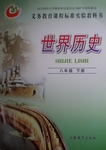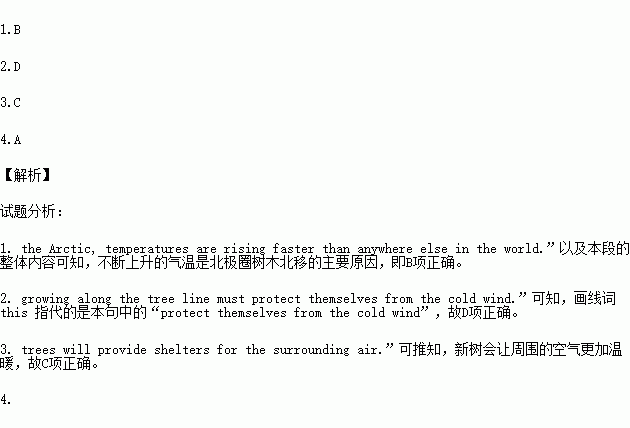题目内容
阅读理解。
Even if trees cannot walk, they are still on the move.
In parts of the Arctic, entire forests are moving northward. Across the Arctic, temperatures are rising faster than anywhere else in the world. As that happens, the tree line that marks where forests stop and the treeless tundra (冻原) starts has been shifting northward. Trees growing along the tree line must protect themselves from the cold wind. To do this,_plants tend to grow horizontal (水平的) branches low to the ground. The energy it takes for trees to grow this way means they don't have enough energy to make seeds.
But as Earth's climate has been warming, trees no longer have to just grow horizontally. Many can instead grow up toward the sky. This takes less energy. And with all that leftover energy, these trees have started producing more seeds. This happens especially in places where white spruce (白云杉) grows.
White spruce, which is a North American tree, is quite able to produce a lot of seeds, which can move long distances in the wind. When wind?blown seeds end up on the tundra beyond the tree line, they eventually can sprout(发芽) new trees. This explains how a forest can move. Of course, the process would work only if the tundra were warm enough. But in recent years, the whole planet has been warming.
New trees will provide shelters for some snow. Keeping the sun's rays from making the white surface disappear. Instead, the trees absorb the sun's heat. This warms the surrounding air. The extra warmth encourages even more trees to produce seeds. That further boosts a forest's ability to expand. In addition, more trees will trap more snow, preventing much of it from being blown away. Snow can trap heat in the soil below, which encourages trees to grow. The recent rise of temperatures has helped more trees grow past the tree line. People worry about impacts on the animals that depend on frozen conditions for food and shelter.
1.What is the main cause of the trees in the Arctic moving northward?
A.The shrinking of northern tundra.
B.The rising temperature.
C.The fierce and cold wind.
D.The abundant resources in the north.
2.What does the underlined word “this” in Paragraph 2 mean?
A.To produce more seeds.
B.To move northward.
C.To respond to the climate change.
D.To protect themselves from the cold wind.
3.What can be inferred from the last paragraph?
A.New trees can trap the snow, which may make the soil colder.
B.The trapped snow prevents new trees from producing more seeds.
C.New trees can make the surrounding air warmer.
D.New trees can bring more food and shelter to local animals.
4.The passage is most probably taken from ________.
A.a science report B.a health report
C.a fashion magazine D.a children's magazine
 探究与巩固河南科学技术出版社系列答案
探究与巩固河南科学技术出版社系列答案书面表达
五一小长假即将来临, 你班同学就五一假期计划进行讨论,提出了不同看法,请根据提示写一篇短文,并谈谈你的看法。
优 点 | 缺 点 | |
待在家中 | 花费少、舒适方便 | 不能亲身了解外界 |
外出旅游 | 增长知识、开阔眼界 | 花费多、旅途不便 |
注意:
1 .词数100左右(不含已写好部分)。
2. 短文必须包括表中所列要点,可根据内容分段表述。
3. 可适当增加细节,以使行文连贯。参考词汇:眼界horizon (view)
The May Day is coming. Our class has a discussion about what to do during the holiday.______

